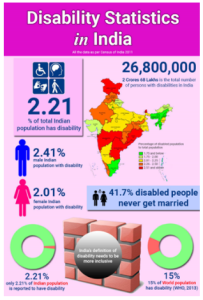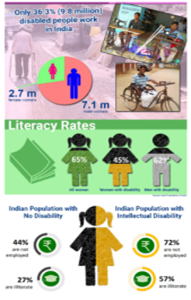Context: According to the Parliamentary Standing Committee on Social Justice and Empowerment, the Union government has failed to accurately estimate the current population of Persons with Disabilities (PwDs) in the country.
About PwDs (Divyangjan):


News Source: The Hindu

- Rights of Persons with Disabilities Act, 2016 defines “Person with Benchmark Disability” as “A person with not less than 40% of a specified disability”.
- United Nations Convention on the Rights of Persons with Disabilities (UN CRPD) defines “Persons with disabilities include those people having long term physical, mental, intellectual or sensory impairments which in interaction with various barriers may hinder their full and effective participation in society on an equal basis with others“.
- According to the Indian Government, data on PwDs are largely taken from the decennial censuses and sample surveys on disability.
- According to 2011 Census, the number of people with disabilities in India is close to 2.68 crore (or 2.2% of the population) — that is more than the entire population of Australia.
- As per the National Statistics Office report 2021, about 2.2% of India’s population lives with some kind of physical or mental disability.
- Rural men had the highest prevalence of disability in India.

- Inadequate infrastructure: Many public buildings, spaces, and transportation systems in India are not designed to be accessible for PwDs. This includes lack of ramps, lifts, and accessible toilets.
- Poor implementation of accessibility guidelines: Although there are guidelines for making buildings and spaces accessible, they are often not implemented properly.
- Lack of assistive technology: Access to assistive technology, such as hearing aids and mobility aids, is limited in India, making it difficult for Divyangjan to perform daily tasks.
- Limited access to information and communication: Persons with visual and hearing impairments often face challenges in accessing information and communication due to the lack of Braille signage, sign language interpretation, and audio descriptions.
- Attitudinal barriers: They often face discrimination and stigma due to negative attitudes and stereotypes held by society. This can limit their opportunities and participation in society.
- Indian Constitution: Indian Government is under obligation to provide for better living conditions to PwDs in India under Indian Constitution.
- Article 21: No person shall be deprived of his life or personal liberty except according to the procedure established by law.
- Rights of Persons with Disabilities Act, 2016: It is the disability legislation passed by the Indian Parliament to fulfil its obligation to the United Nations Convention on the Rights of Persons with Disabilities, which India ratified in 2007.
Salient Feature of Rights of Persons with Disabilities Act, 2016:
|
- Assistance to Disabled persons for purchasing / fitting of aids / appliances (ADIP) scheme: It is implemented through implementing agencies such as the NGOs, National Institutes under this Ministry and ALIMCO (a PSU).
- Objective: To assist the needy disabled persons in procuring durable, sophisticated and scientifically manufactured, modern, standard aids and appliances that can promote their physical, social and psychological rehabilitation, by reducing the effects of disabilities and enhance their economic potential.
- Unique Disability ID, or UDID: It would help create a national database for persons with disabilities, “encourage transparency, efficiency and ease of delivering the government benefits” and for “stream-lining the tracking of physical and financial progress” of beneficiaries at all levels.
- Accessible India Campaign (Sugamya Bharat Abhiyan): It aims to make public spaces, transportation, and information and communication technologies (ICT) accessible to PwDs.
- In the upcoming census, disability will be defined as per the Rights of Persons with Disabilities (or RPwD) Act of 2016.
- Department of disability affairs is also in the process of creating a national database of PwDs, which will contain information on those with certificates issued by competent medical authorities.
- Promoting inclusive education for children with disabilities in regular schools, and providing them with adequate support, resources, and training. This can help them develop their potential and skills, and integrate them into the society.
- Enhancing the accessibility of physical environment, transportation, information and communication, technology and services for persons with disabilities, and removing any barriers or obstacles that hinder their participation and inclusion.
- Increasing the opportunities and incentives for vocational training, skill development, self-employment, and formal employment for persons with disabilities, and ensuring non-discrimination and equal pay in the labor market.
- Providing social security benefits, healthcare services, insurance schemes, rehabilitation programs, and other welfare measures for persons with disabilities, and ensuring their affordability and quality.
- Raising awareness and sensitization among the public, media, government, civil society, and private sector about the rights, needs, abilities, and contributions of persons with disabilities, and challenging the negative stereotypes and stigma associated with disability.
- Encouraging the participation and representation of persons with disabilities and their organizations in decision-making processes at all levels, and ensuring their voice and choice in matters affecting them.
- Supporting research and innovation in the field of disability, and promoting the dissemination and exchange of best practices and knowledge on disability inclusion.
- Collaborating with State governments, using data from surveys they are conducting, consulting experts, and sensitizing surveyors of the Ministry of Statistics.
- Implementing and enforcing the existing laws and policies that protect the rights and interests of persons with disabilities, such as the Rights of Persons with Disabilities Act, 2016 and the Draft National Policy for Persons with Disabilities, 2022.
|
Post Views: 194
